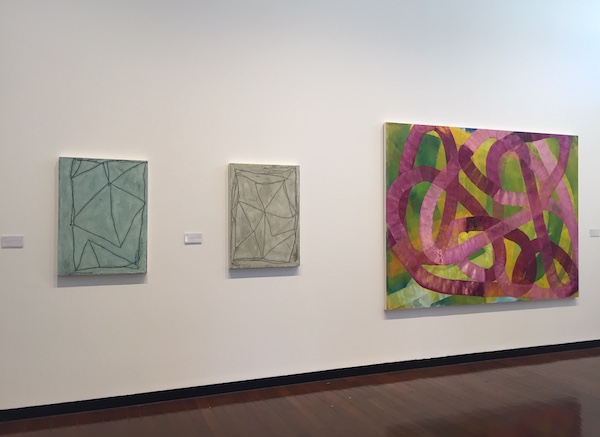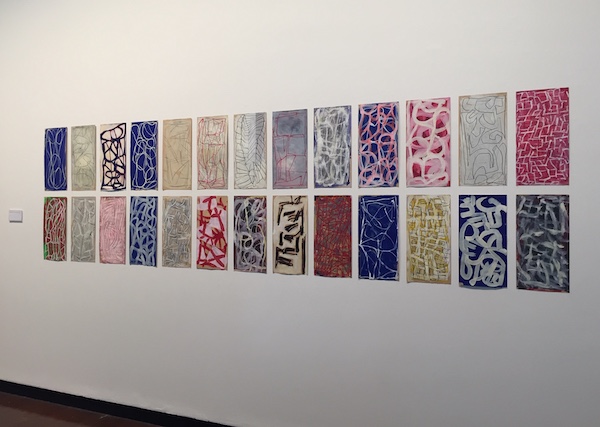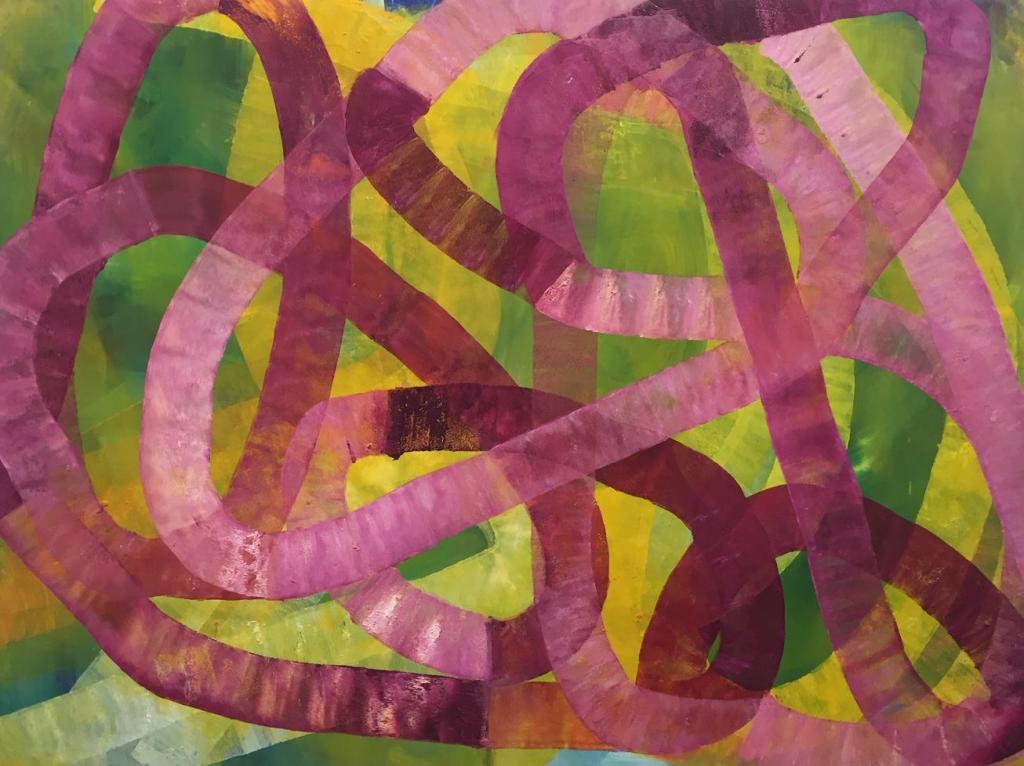Detail Sunlit (2015), oil on plywood, private collection. Image courtesy of the artist.
If you are a fan of big gestural abstraction then you are going to love the survey exhibition, The DNA of Colour: Ildiko Kovacs, curated by Sioux Garside jointly for Orange Regional Gallery and Drill Hall Gallery, where it is currently on show.
It is almost impossible to get a show wrong at ANU’s Drill Hall – its warm timber floors, dappled natural light and comfortably scaled spaces allows work to sing, and Kovacs’ exhibition with its punchy ribbons of colour and sweeping energy is right at home here.
Kovacs is one of Australia’s leading abstractionists; she won the prestigious Bulgari Art Award in 2015, and in 2011 had a major survey Down the Line 1980-2010 (with publication) at Hazelhurst Regional Gallery and Arts Centre.
That might beckon one to ask: How is this exhibition different? And should we be taking another dip at a survey of Kovacs’ work?
This exhibition steps forward from that past show and takes its cue from a moment in 2010 when Kovacs took a decided shift in the work, and turned to paint rollers to create freer, bolder gestures on plywood – essentially, it’s the next chapter.
Garside said in curating the exhibition: ‘In thinking about Kovacs’ abstract paintings I was struck by the resemblance of her spiraling lines to the coils of DNA … Her rippling forms seem to twist into a vortex or follow an unravelling double helix pattern.’
Whether bouncing off DNA strands or not, there is a decided lineage in the way this work has spiralled into a fresh conversation.
Garside’s exhibition intersperses these ‘roller works’ of the past decade with an even more recent shift in style – softer, more spidery abstractions made by incising deep graphite pencil lines into thick layers of paint.
Walking into the gallery, this story of stylistic chapters and shifts is immediately introduced with the paintings Wire III (2019) and Wire I (2019) with the earlier Sunlit (2015), popping with its palette of pinks and greens. They feel more angular, and yet hold a softness within their form and surface – their surfaces seemingly carry a history like skin.

From left, Wire III (2019), Wire 1 (2019) and the earlier Sunlit (2015); installation view at Drill Hall Gallery (2019). Photo: ArtsHub.
These Wire panels sit adjacent to the painting Full moon (2001), made nearly a decade earlier. The journey is clearly visible – or as Garside would infer – their DNA.
These incised works have been shown less – Kovacs was really just getting her head around them last year – but when you hopscotch across this show they hold their own, with their pulled back scale and palette offering pause from the more ballsy gestures of the earlier paintings.
In the central gallery space are a number of expansive works, among them the pairing of Kovacs’ Bulgari winning painting Onda with Over the Gap (2015) – with a stripped back, weighty blue line on a punchy orange background – and adjacent In Flight, also painted in the same year and now in the collection of the National Gallery of Australia.

From left, In Flight (2015) and Over the Gap (2015), installation view Drill Hall Gallery; photo Artshub
In it, that same blue line seeming takes a dance with a rollered white line – elegant, seductive, classy and piqued. It is a great example of Kovacs capacity to dodge and weave a line while building space within a painting.
Garside has pulled from major collections of Museum of Contemporary Art, the Art Gallery of New South Wales, the NGA as mentioned and the Newcastle Art Gallery, as well as works rarely seen held in private collections.
One of those in private holdings is India (2011). As a colourist, it perhaps best describes Kovacs’ understanding of landscape within abstraction. Much has been written in the past of her living in outback Australia and its influence in a kind of topographical physicality of painting, but this painting on its earthy ground captures the pink of saris, the bleached light of India and the sacred saffron yellows that are the essences of this place.

Installation view India (2011), oil on plywood, private collection.
In the rear gallery, the viewer can still smell the paint fresh to some of these boards. It adds to our own physical experience of Kovacs’ work as a viewer.
This is further played out in a wonderful suite of 26 drawings from the studio, which offer an intimate moment against the scale of this show. In these small works on paper we see a history of abstraction; a history of Kovacs.

Installation view of Drill Hall Gallery suite of 26 drawings. Photo: ArtsHub.
When I last interviewed Kovacs a couple of years back, it was her description of working in the studio that stuck with me. She spoke of the physicality of reaching a full arm’s expanse, making a gesture, standing back, then throwing turps on it and rubbing it off and doing it again – a process repeated to the point of exhaustion; finding the marks, the layers, the spirit that seemingly breathes within her paintings.
That same repetition – an almost meditative like consideration; a compulsion – is seen in these small drawings.
Just shy of 40 paintings, this exhibition speaks as much about a committed studio practice, and the working through of an idea, as it does machinations on an abstract theme. That Kovacs continues to push her medium, to find new expression, while remaining true to the language that has driven her for thirty plus years – her DNA as Garside suggests – is testament to her reputation as one of our great abstractionists.
Despite the scale of this show, it is not overwhelming, but rather has a loose lightness to it. The filtered light in the gallery space almost seems to let that spirit float; it is quiet palpable for the viewer – and definitely worth taking in.
3.5 stars out of 5 ★★★☆The DNA of Colour: Ildiko Kovacs
ANU Drill Hall Gallery
20 June-11 August 2019
Curated by Sioux Garside
Supported by Martin Browne Contemporary





